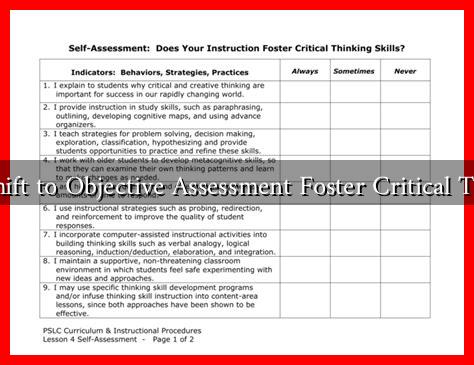-
Table of Contents
Can a Shift to Objective Assessment Foster Critical Thinking?
In the evolving landscape of education, the debate surrounding assessment methods has gained significant traction. Traditional assessment methods, often reliant on subjective grading, have been criticized for failing to accurately measure a student’s critical thinking abilities. This article explores whether a shift to objective assessment can indeed foster critical thinking among students, examining the implications, benefits, and potential drawbacks of such a transition.
The Nature of Objective Assessment
Objective assessments are designed to measure knowledge and skills through standardized questions that yield clear right or wrong answers. Common forms include multiple-choice tests, true/false questions, and fill-in-the-blank exercises. The primary advantage of objective assessments is their ability to provide consistent and unbiased results. However, critics argue that these assessments often fail to capture the nuances of critical thinking.
Understanding Critical Thinking
Critical thinking is defined as the ability to analyze information, evaluate evidence, and construct reasoned arguments. It involves higher-order thinking skills that go beyond rote memorization. According to the American Philosophical Association, critical thinking encompasses:
- Analysis
- Evaluation
- Inference
- Explanation
- Problem-solving
Given this definition, the question arises: can objective assessments effectively measure and promote these skills?
The Case for Objective Assessment
Proponents of objective assessments argue that they can foster critical thinking in several ways:
- Standardization: Objective assessments provide a uniform measure of student performance, allowing educators to identify trends and gaps in understanding across a diverse student population.
- Immediate Feedback: These assessments often allow for quicker grading and feedback, enabling students to recognize their strengths and weaknesses in real-time.
- Focus on Core Knowledge: By emphasizing foundational knowledge, objective assessments can free up cognitive resources for higher-order thinking tasks.
For instance, a study conducted by the National Center for Education Statistics found that students who engaged in frequent objective assessments demonstrated improved retention of core concepts, which is essential for critical thinking.
Limitations of Objective Assessment
Despite the potential benefits, there are significant limitations to relying solely on objective assessments:
- Surface Learning: Objective assessments may encourage surface learning, where students focus on memorization rather than understanding concepts deeply.
- Lack of Context: These assessments often fail to provide context for questions, which can hinder students’ ability to apply knowledge in real-world scenarios.
- Neglect of Soft Skills: Critical thinking also involves communication and collaboration, skills that are not easily measured through objective means.
For example, a study published in the Journal of Educational Psychology found that students who primarily engaged with objective assessments scored lower on measures of critical thinking compared to those who participated in project-based learning and subjective assessments.
Integrating Objective and Subjective Assessments
To truly foster critical thinking, a balanced approach that integrates both objective and subjective assessments may be the most effective strategy. This hybrid model can include:
- Objective Quizzes: To assess foundational knowledge and ensure students have the necessary background to engage in critical thinking.
- Project-Based Assessments: To encourage application of knowledge in real-world contexts, promoting deeper understanding and critical analysis.
- Peer Reviews: To develop communication skills and provide opportunities for collaborative critical thinking.
Research from the University of California, Berkeley, supports this integrated approach, showing that students who experienced a mix of assessment types performed better in critical thinking tasks than those who relied solely on one method.
Conclusion
In conclusion, while a shift to objective assessment can provide valuable insights into student performance and foster certain aspects of critical thinking, it is not a panacea. The limitations of objective assessments highlight the need for a more comprehensive approach that includes subjective measures. By integrating both assessment types, educators can create a more holistic learning environment that not only evaluates knowledge but also nurtures critical thinking skills essential for success in the 21st century.
For further reading on assessment methods and their impact on learning, consider exploring resources from the George Lucas Educational Foundation.

